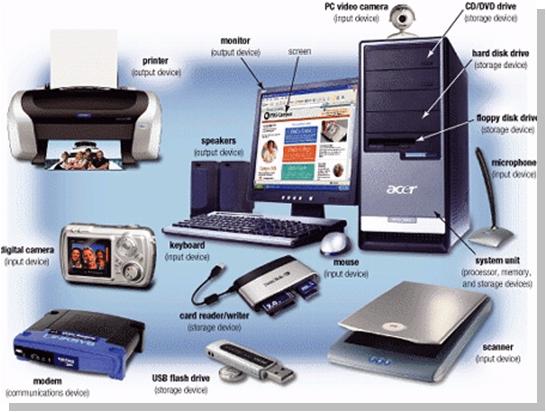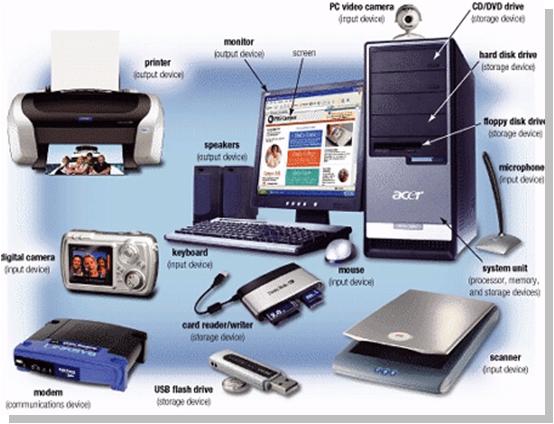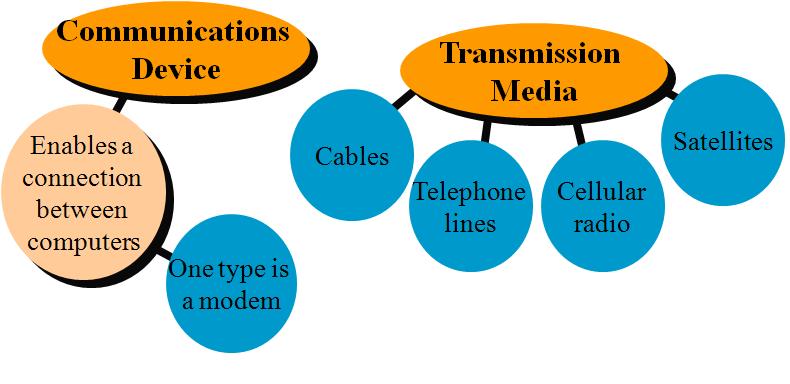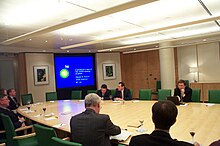-Komponen-komponen sebuah komputer
-Software
-Network dan Internet
-Pemanfaat internet untuk update informasi
Berikut adalah kesimpulan-kesimpulan yang dapat diperoleh dari Bu Tri mengenai
Penerapan Teknologi Informasi :
Definisi Teknologi Informasi adalah sebuah istilah yang mencakup seluruh bentuk
teknologi yang digunakan untuk membuat, menyimpan, tukar menukar dan membuat
informasi dalam berbagai bentuk/format (business data, voice conversations,
images, motion pictures, presentasi multimedia dll, termasuk didalamnya
informasi yang belum tersusun dengan rapi). Teknologi yang termasuk didalamnya
adalah teknologi telephone/telekomunikasi dan teknologi komputer.
information processing cycle meliputi :
-Input
-Process
-Output
-Storage
-Communication
Komponen Komputer :
-Input Device
-Output Device
-System Unit
-Storage
-Communication Device
-input device : Hardware yang peralatan di sistem komputer yang
scr fisik terlihat dan dapat dijamah dan digunakan untuk memasukan data dan
instruksi
 -output device :
-output device : Hardware yang menampilkan informasi ke satu atau
lebih orang
 system unit :
system unit : Kotak yang berisi komponen elektronik yang digunakan
untuk memproses data menjadi informasi
-storage : Tempat menyimpan data, instruksi, dan informasi untuk
kebutuhan di masa yang akan datang
Storage dibagi lagi menjadi :
Storage media
Physical material yang digunakan untuk menyimpan data, instruksi dan informasi
Contoh : Digital Camera,Handheld Computer
Storage device
Peralatan yang digunakan untuk menemukan kembali record atau item Records
and retrieves yang ada dalam storage medium
Contoh: Flashdisk,Harddisk, Floopy Disk
-Communications device : Komponen dari hardware yang ada didalam komputer
Untuk mengirim data, instruksi dan informasi ke komputer lain Melalui kabel,
telephone lines, cellular radio networks, satellites dan media transmisi yang
lainnya
software :
Perintah-perintah untuk komputer melakukan sesuatu(mengolah data)
graphical user interface (GUI) : Sebuah interface yang memungkinkan kita
berinteraksi dengan software dengan menggunakan graphics dan icons. GUI
mengontrol pengentrian data dan bagaimana sebuah display/tampilan informasi
tampil di layar
system software : Program yang mengontrol atau memaintain operasional
komputer dan device lain yang terhubung kepadanya
Dalam System Software dibagi lagi menjadi :
Operating System (OS) : suatu programs yang berfungsi untuk memanajemen
operasi-operasi dalam komputer meliputi hardware dan penggunaan software oleh
user
Utility Programs : program yang mengijinkan user untuk melakukan tugas
maintenance (umumnya berkaitan dengan memanage komputer dan Programs)
application software : Program yang menjalankan task/tugas secara
spesifik untuk user
programmer : Seseorang yang mendevelop application software atau system
software
network (jaringan komputer) : Kumpulan dari beberapa komputer dan network
device yang saling terhubung satu dengan lainnya
 Internet :
Internet : Kumpulan network (worldwide collection of networks) yang
mengkoneksikan berjuta-juta pelaku bisnis, pemerintahan, institusi pendidikan,
individu dsb sehingga bisa saling komunikasi dan bertukar informasi

Alasan kita mengakses Internet :
-Communications
-Information
-Shopping
-Banking and Investing
-Classes
-Entertainment
Berikut adalah
Tips dan Trick dalam Googling dan Browsing
-Googling
*Must know � How to make the best search�
*Best keyword = Best results
*Always use advanced search
-Browsing
*Use multiple tab browser
*Smart browsing
Dan
minggu depan pertemuan tentang PTI(penerapan Teknologi Informasi)yang
dibawakan oleh Bu Tri Sagirani akan membahas tentang Input
Device..Berjuang y bu..hohoho (kayak hari kemerdekaan aja xixixixi :p)
Contact Us
Ericova Project Indonusa
Jl. Gatot Subroto 49 Sidoarjo
Telp : 031-770-19012
Handphone : 089-934-63715
Pin BB : 75BC816A
Fax : 031-8963256
Web : http://www.ericova.com
Email : info@ericova.com

Multimedia
From Wikipedia, the free encyclopedia
Multimedia refers to
content that uses a combination of different
content forms.
This contrasts with media that use only rudimentary computer displays
such as text-only or traditional forms of printed or hand-produced
material. Multimedia includes a combination of
text,
audio,
still images,
animation,
video, or
interactivity content forms.
Multimedia is usually recorded and played, displayed, or accessed by
information content
processing devices, such as computerized and electronic devices, but
can also be part of a live performance. Multimedia devices are
electronic media devices used to store and experience multimedia content. Multimedia is distinguished from
mixed media in
fine art; by including audio, for example, it has a broader scope. The term "rich media" is synonymous for
interactive multimedia.
Hypermedia can be considered one particular multimedia application.
Categorization of multimedia
Multimedia may be broadly divided into
linear and
non-linear categories. Linear active content progresses often without any navigational control for the viewer such as a
cinema presentation. Non-linear uses
interactivity to control progress as with a
video game or self-paced
computer based training.
Hypermedia is an example of non-linear content.
Multimedia
presentations can be
live or
recorded. A recorded presentation may allow interactivity via a
navigation system. A live multimedia presentation may allow interactivity via an interaction with the presenter or performer.
Major characteristics of multimedia
Multimedia presentations may be viewed by person on
stage,
projected,
transmitted, or played locally with a
media player. A
broadcast may be a live or recorded multimedia presentation. Broadcasts and recordings can be either
analog or
digital electronic media technology. Digital
online multimedia may be downloaded or
streamed. Streaming multimedia may be live or on-demand.
Multimedia games and simulations may be used in a physical environment with special effects, with multiple users in an online
network, or locally with an offline computer,
game system, or
simulator.
The various formats of technological or digital multimedia may be
intended to enhance the users' experience, for example to make it easier
and faster to convey information. Or in entertainment or art, to
transcend everyday experience.

A
lasershow is a live multimedia performance.
Enhanced levels of interactivity are made possible by combining multiple forms of media content.
Online multimedia is increasingly becoming object-oriented and data-driven, enabling applications with
collaborative end-user innovation and
personalization
on multiple forms of content over time. Examples of these range from
multiple forms of content on Web sites like photo galleries with both
images (pictures) and title (text) user-updated, to simulations whose
co-efficients, events, illustrations, animations or videos are
modifiable, allowing the multimedia "experience" to be altered without
reprogramming. In addition to seeing and hearing,
Haptic technology enables virtual objects to be felt. Emerging technology involving illusions of
taste and
smell may also enhance the multimedia experience.
Terminology
History of the term
The term
multimedia was coined by singer and artist Bob Goldstein (later '
Bobb Goldsteinn') to promote the July 1966 opening of his "LightWorks at L'Oursin" show at
Southampton,
Long Island. Goldstein was perhaps aware of a British artist named Dick
Higgins, who had two years previously discussed a new approach to
art-making he called "intermedia."
[1]
On August 10, 1966, Richard Albarino of
Variety borrowed the terminology, reporting: "Brainchild of songscribe-comic Bob ('
Washington Square') Goldstein, the 'Lightworks' is the latest
multi-media music-cum-visuals to debut as discothèque fare."
[2]
Two years later, in 1968, the term "multimedia" was re-appropriated to
describe the work of a political consultant, David Sawyer, the husband
of Iris Sawyer—one of Goldstein’s producers at L’Oursin.

Multimedia (multi-image) setup for the 1988 Ford New Car Announcement Show, August 1987, Detroit, MI
In the intervening forty years, the word has taken on different
meanings. In the late 1970s, the term referred to presentations
consisting of
multi-projector slide shows timed to an audio track.
[3][4] However, by the 1990s 'multimedia' took on its current meaning.
In the 1993 first edition of McGraw-Hill’s
Multimedia: Making It Work,
Tay Vaughan declared “Multimedia is any combination of text, graphic
art, sound, animation, and video that is delivered by computer. When you
allow the user – the viewer of the project – to control what and when
these elements are delivered, it is
interactive multimedia. When you provide a structure of linked elements through which the user can navigate, interactive multimedia becomes
hypermedia.”
[5]
The German language society,
Gesellschaft für deutsche Sprache,
decided to recognize the word's significance and ubiquitousness in the
1990s by awarding it the title of 'Word of the Year' in 1995. The
institute summed up its rationale by stating "[Multimedia] has become a
central word in the wonderful new media world"
[6]
In common usage,
multimedia refers to an electronically
delivered combination of media including video, still images, audio,
text in such a way that can be accessed interactively. Much of the
content on the web today falls within this definition as understood by
millions. Some computers which were marketed in the 1990s were called
"multimedia" computers because they incorporated a CD-ROM drive, which
allowed for the delivery of several hundred megabytes of video, picture,
and audio data. That era saw also a boost in the production of
educational multimedia
CD-ROMs.
Word usage and context
Since media is the plural of medium, the term "multimedia" is used to
describe multiple occurrences of only one form of media such as a
collection of
audio CDs. This is why it's important that the word "multimedia" is used exclusively to describe
multiple forms of media and content.
The term "multimedia" is also ambiguous. Static content (such as a
paper book) may be considered multimedia if it contains both pictures
and text or may be considered interactive if the user interacts by
turning pages at will. Books may also be considered non-linear if the
pages are accessed non-sequentially. The term "video", if not used
exclusively to describe motion photography, is ambiguous in multimedia
terminology.
Video is often used to describe the file format, delivery format, or presentation format instead of
"footage" which is used to distinguish motion
photography from
"animation" of
rendered
motion imagery. Multiple forms of information content are often not
considered modern forms of presentation such as audio or video.
Likewise, single forms of information content with single methods of
information processing (e.g. non-interactive audio) are often called
multimedia, perhaps to distinguish
static media from
active media. In the
Fine arts, for example,
Leda Luss Luyken's
ModulArt
brings two key elements of musical composition and film into the world
of painting: variation of a theme and movement of and within a picture,
making
ModulArt an
interactive multimedia form of art.
Performing arts may also be considered multimedia considering that performers and
props are multiple forms of both content and media.
The
Gesellschaft für deutsche Sprache chose
Multimedia as
German Word of the Year 1995.
[7]
Usage / Application

A presentation using
Powerpoint. Corporate presentations may combine all forms of media content.

VVO Multimedia-Terminal in
Dresden WTC (Germany)
Multimedia finds its application in various areas including, but not limited to,
advertisements,
art,
education,
entertainment,
engineering,
medicine,
mathematics,
business,
scientific research and
spatial temporal applications. Several examples are as follows:
Creative industries
Creative industries use multimedia for a variety of purposes ranging from fine arts, to entertainment, to commercial art, to
journalism,
to media and software services provided for any of the industries
listed below. An individual multimedia designer may cover the spectrum
throughout their career. Request for their skills range from technical,
to analytical, to creative.
Commercial uses
Much of the electronic
old and
new media used by commercial artists is multimedia. Exciting presentations are used to grab and keep attention in
advertising. Business to business, and interoffice communications are often developed by
creative services
firms for advanced multimedia presentations beyond simple slide shows
to sell ideas or liven-up training. Commercial multimedia developers may
be hired to design for
governmental services and
nonprofit services applications as well.
Entertainment and fine arts
In addition, multimedia is heavily used in the entertainment industry, especially to develop
special effects
in movies and animations(VFX, 3D animation, etc.). Multimedia games are
a popular pastime and are software programs available either as CD-ROMs
or online. Some
video games
also use multimedia features. Multimedia applications that allow users
to actively participate instead of just sitting by as passive recipients
of information are called
Interactive Multimedia. In the
Arts there are
multimedia artists,
whose minds are able to blend techniques using different media that in
some way incorporates interaction with the viewer. One of the most
relevant could be
Peter Greenaway who is melding
Cinema with
Opera
and all sorts of digital media. Another approach entails the creation
of multimedia that can be displayed in a traditional fine arts arena,
such as an
art gallery.
Although multimedia display material may be volatile, the survivability
of the content is as strong as any traditional media. Digital recording
material may be just as durable and infinitely reproducible with
perfect copies every time.
Education
In
Education, multimedia is used to produce
computer-based training
courses (popularly called CBTs) and reference books like encyclopedia
and almanacs. A CBT lets the user go through a series of presentations,
text about a particular topic, and associated illustrations in various
information formats.
Edutainment is the combination of education with entertainment, especially multimedia entertainment.
Learning theory in the past decade has expanded dramatically because
of the introduction of multimedia. Several lines of research have
evolved (e.g.
Cognitive load,
Multimedia learning, and the list goes on). The possibilities for learning and instruction are nearly endless.
The idea of media convergence is also becoming a major factor in
education, particularly higher education. Defined as separate
technologies such as voice (and telephony features), data (and
productivity applications) and video that now share resources and
interact with each other, synergistically creating new efficiencies,
media convergence is rapidly changing the curriculum in universities all
over the world. Likewise, it is changing the availability, or lack
thereof, of jobs requiring this savvy technological skill.
The English education in middle school in China is well invested and
assisted with various equipments. In contrast, the original objective
has not been achieved at the desired effect. The government, schools,
families, and students spend a lot of time working on improving scores,
but hardly gain practical skills. English education today has gone into
the vicious circle. Educators need to consider how to perfect the
education system to improve students’ practical ability of English.
Therefore an efficient way should be used to make the class vivid.
Multimedia teaching will bring students into a class where they can
interact with the teacher and the subject. Multimedia teaching is more
intuitive than old ways; teachers can simulate situations in real life.
In many circumstances teachers do not have to be there, students will
learn by themselves in the class. More importantly, teachers will have
more approaches to stimulating students’ passion of learning.
Journalism
Newspaper companies all over are also trying to embrace the new
phenomenon by implementing its practices in their work. While some have
been slow to come around, other major newspapers like
The New York Times,
USA Today and
The Washington Post are setting the precedent for the positioning of the newspaper industry in a globalized world.
News reporting is not limited to traditional media outlets. Freelance
journalists can make use of different new media to produce multimedia
pieces for their news stories. It engages global audiences and tells
stories with technology, which develops new communication techniques for
both media producers and consumers.
Common Language Project is an example of this type of multimedia journalism production.
Multimedia reporters who are mobile (usually driving around a
community with cameras, audio and video recorders, and wifi-equipped
laptop computers) are often referred to as
Mojos, from
mobile
journalist.
Engineering
Software engineers may use multimedia in
Computer Simulations for anything from entertainment to
training such as military or industrial training. Multimedia for
software interfaces are often done as a collaboration between
creative professionals and software engineers.
Industry
In the
Industrial sector,
multimedia is used as a way to help present information to
shareholders, superiors and coworkers. Multimedia is also helpful for
providing employee training, advertising and selling products all over
the world via virtually unlimited web-based technology.
Mathematical and scientific research
In
mathematical and
scientific research, multimedia is mainly used for modeling and simulation. For example, a
scientist can look at a
molecular model
of a particular substance and manipulate it to arrive at a new
substance. Representative research can be found in journals such as the
Journal of Multimedia.
Medicine
In
Medicine,
doctors can get trained by looking at a virtual
surgery or they can simulate how the
human body is affected by
diseases spread by
viruses and
bacteria and then develop techniques to prevent it.
Document imaging
Document imaging is a technique that takes hard copy of an image/document and converts it into a digital format (for example, scanners).
Disabilities
Ability Media allows those with disabilities to gain qualifications
in the multimedia field so they can pursue careers that give them access
to a wide array of powerful communication forms.
Miscellaneous
In Europe, the reference organisation for Multimedia industry is the
European Multimedia Associations Convention (EMMAC).
Structuring information in a multimedia form
Multimedia represents the
convergence
of text, pictures, video and sound into a single form. The power of
multimedia and the Internet lies in the way in which information is
linked.
Multimedia and the Internet require a completely new approach to
writing. The style of writing that is appropriate for the 'on-line
world' is highly optimized and designed to be able to be quickly scanned
by readers.
[8]
A good site must be made with a specific purpose in mind and a site
with good interactivity and new technology can also be useful for
attracting visitors. The site must be attractive and innovative in its
design, function in terms of its purpose, easy to navigate, frequently
updated and fast to download.
[9]
When users view a page, they can only view one page at a time. As a
result, multimedia users must create a ‘mental model of information
structure’.
[10]
Conferences
There is a
large number of multimedia conferences, the two main scholarly scientific conferences being:
[citation needed]
See also



























No comments:
Post a Comment